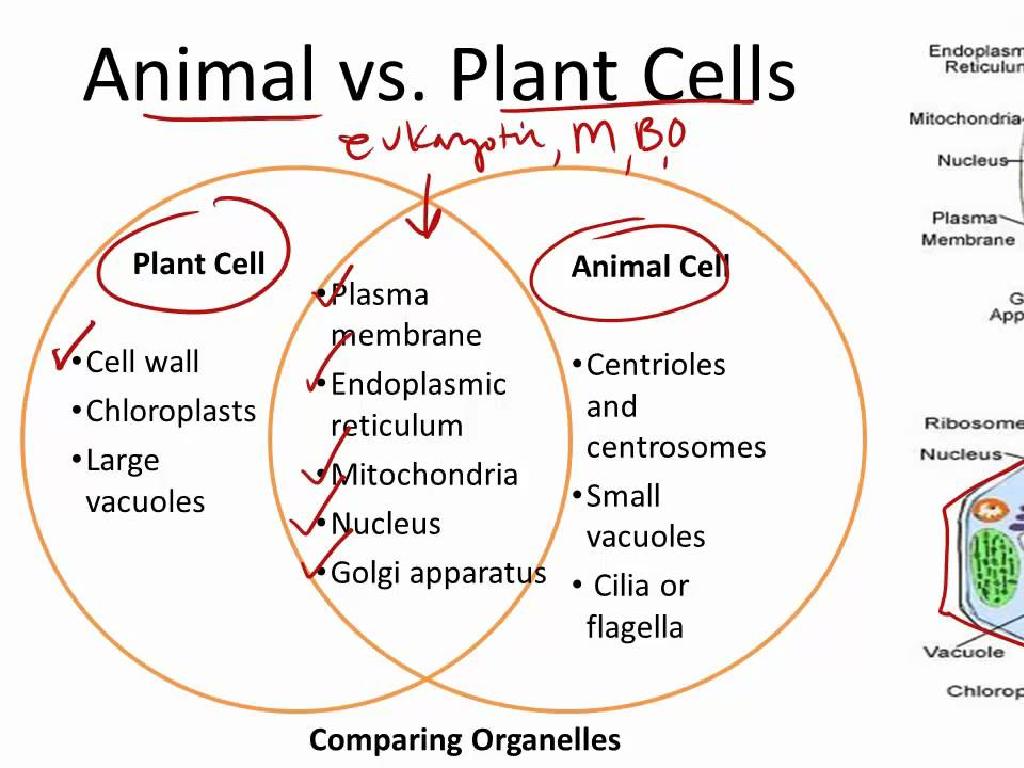The Cell Cycle And Differentiation
Subject: Science
Grade: High school
Topic: Biology
Please LOG IN to download the presentation. Access is available to registered users only.
View More Content
Introduction to Cell Biology
– Cells: Life’s building blocks
– Smallest unit of life, fundamental to all living things.
– Importance of cells in organisms
– Cells are essential for structure, function, and regulation of body’s tissues and organs.
– Overview of the cell cycle
– The process by which cells grow and divide to replenish and repair.
– Cell differentiation explained
– How cells develop into specialized types with unique functions.
|
This slide introduces students to the fundamental concepts of cell biology. Begin by explaining that cells are the basic structural, functional, and biological units of all living organisms, often referred to as the ‘building blocks of life’. Emphasize the importance of cells in the makeup of every part of an organism, and their role in the overall functioning of life. Provide a brief overview of the cell cycle, highlighting the stages of growth (interphase) and division (mitosis), and explain how this process is crucial for growth and maintenance of an organism. Discuss cell differentiation as the process by which a less specialized cell becomes a more specialized cell type, which is essential for creating the diverse range of cells needed in a multicellular organism. Encourage students to think about how the different cell types in their own bodies function to support their health and activities.
The Cell Cycle: Phases and Regulation
– Phases: Interphase, Mitosis, Cytokinesis
– Interphase prepares the cell, Mitosis divides the nucleus, Cytokinesis splits the cell
– Cell Cycle in Growth and Repair
– The cycle enables cells to grow and heal damaged tissues
– Regulation of the Cell Cycle
– Cell cycle checkpoints prevent errors in cell division
– Significance of Cycle Regulation
– Proper regulation ensures healthy growth and prevents diseases like cancer
|
This slide provides an overview of the cell cycle, emphasizing its phases, role in organismal growth and repair, and the importance of its regulation. Interphase is the phase where the cell grows and prepares for division, mitosis is the division of the nucleus, and cytokinesis is the final split of the cell into two. The cell cycle is crucial for the growth of organisms and the repair of damaged tissues. Regulation mechanisms, including various checkpoints, are essential to prevent errors during cell division, which can lead to diseases such as cancer. Discuss the implications of dysregulation in the cell cycle, and how it is a focus of intense research, especially in the context of cancer biology.
The Cell Cycle: Interphase
– Interphase: Longest cell cycle phase
– Interphase prepares the cell for division, occupying most of the cell’s lifespan.
– Sub-phases: G1, S, G2
– G1: Cell grows, S: DNA replicates, G2: Cell prepares for mitosis.
– Cell growth during Interphase
– Cells increase in size, produce RNA, synthesize proteins.
– DNA replication process
– DNA replication is crucial for genetic continuity in daughter cells.
|
Interphase is a critical period of the cell cycle where the cell prepares for division. It’s divided into three sub-phases: G1 (Gap 1), where the cell grows and performs its normal functions; S (Synthesis), where the cell replicates its DNA; and G2 (Gap 2), where the cell continues to grow and prepares for mitosis. During this phase, the cell is metabolically active, increasing in size, and ensuring that all the necessary proteins and organelles are produced for the next phase. DNA replication during the S phase is a key process that ensures each new cell will have an identical set of genetic information. This slide will help students understand the importance of each sub-phase and the activities that occur during Interphase.
Mitosis: Key to Cellular Reproduction
– Purpose of mitosis in cell division
– Mitosis allows for growth and repair by creating identical cells.
– Explore the four stages of mitosis
– Prophase: chromosomes condense. Metaphase: align at center. Anaphase: separate. Telophase: new nuclei form.
– Distinguish mitosis from meiosis
– Mitosis results in two identical cells, while meiosis leads to four genetically different cells.
– Significance in growth and repair
|
This slide introduces students to the concept of mitosis within the cell cycle, emphasizing its role in growth and repair by producing identical daughter cells. Each stage of mitosis is briefly explained to provide a foundational understanding. The comparison between mitosis and meiosis is crucial for students to grasp the differences in outcomes of these processes mitosis for somatic cell replication and meiosis for producing gametes. Highlight the importance of mitosis in maintaining genetic consistency across cells, and discuss how errors in mitosis can lead to issues such as cancer. Encourage students to visualize the stages using diagrams and to remember the key differences between mitosis and meiosis.
Cytokinesis: Final Phase of Cell Division
– Cytoplasm division process
– Cytokinesis is the splitting of the cell’s cytoplasm, completing mitosis.
– Creation of two daughter cells
– Each daughter cell receives half of the cytoplasm and organelles.
– Cytokinesis differs in plants and animals
– In plant cells, a cell plate forms; in animal cells, a cleavage furrow pinches the cell.
– Significance in cell cycle
|
Cytokinesis is a critical stage in the cell cycle, marking the end of cell division where the cytoplasm divides, resulting in two genetically identical daughter cells. It’s important to highlight the differences between plant and animal cytokinesis due to their structural differences. In plant cells, a cell plate forms between the divided nuclei, eventually developing into a separating wall. In contrast, animal cells form a cleavage furrow that constricts the cell membrane to create two separate cells. Understanding these processes is essential for students to grasp the complexities of cell division and its role in growth, development, and maintenance of multicellular organisms.
Cell Differentiation in Multicellular Organisms
– Defining cell differentiation
– The process by which a cell becomes specialized to perform a specific function.
– Exploring stem cells potential
– Stem cells have the unique ability to develop into many different cell types.
– Understanding differentiation process
– Cells undergo changes in structure and function to become specialized.
– Significance of differentiation
– Essential for growth, development, and tissue repair in multicellular organisms.
|
This slide aims to explain the concept of cell differentiation, a crucial process in the development of multicellular organisms. Begin with a definition of cell differentiation, emphasizing how unspecialized cells become specialized to carry out distinct functions. Highlight the role of stem cells, which serve as a sort of ‘blank slate’ and have the remarkable potential to differentiate into various cell types. Discuss the differentiation process, where cells undergo specific changes in gene expression, leading to specialized structures and functions. Lastly, underscore the importance of differentiation for the organism’s growth, development, and ability to repair tissues. Use diagrams of cell differentiation and examples like the development of red blood cells from stem cells to illustrate these concepts.
Cell Differentiation in the Human Body
– Types of differentiated cells
– Muscle, nerve, blood cells, each with unique functions
– Single cell to complex organs
– Zygote divides and cells specialize to form tissues like heart, liver
– Case study: Red blood cells
– Erythropoiesis: Stem cells in bone marrow become red blood cells
– Role in tissue formation
– Differentiation is crucial for creating diverse tissues that work together
|
This slide aims to illustrate the concept of cell differentiation, where unspecialized cells become specialized to perform distinct functions. Highlight the variety of differentiated cells in the human body, such as muscle cells, nerve cells, and blood cells, each with its unique role. Explain the process of how a single fertilized egg, or zygote, divides and differentiates into the complex array of tissues and organs that make up the human body. Use the development of red blood cells as a case study to show differentiation in action, explaining the stages of erythropoiesis. Emphasize the importance of differentiation in the formation of functional tissues and the overall development of an organism. Encourage students to think about how this process is integral to growth and health.
Class Activity: Modeling the Cell Cycle
– Craft a cell cycle model
– Group presentations of models
– Explain phases of the cell cycle
– Include interphase, mitosis, and cytokinesis
– Discuss cell cycle errors and diseases
– Focus on mutations and uncontrolled cell growth
|
This class activity is designed to provide a hands-on learning experience. Students will use craft materials to create a physical model of the cell cycle, which will help them visualize and understand the different phases. Each group will then present their model to the class, explaining the significance of each phase, including interphase, mitosis, and cytokinesis. After the presentations, lead a discussion on how errors in the cell cycle can result in diseases such as cancer, emphasizing the importance of regulation in cell division. Possible activities for different groups could include modeling normal cell division, demonstrating a mutation occurring, or showing the effects of treatment on cancer cells. This will deepen their understanding of the cell cycle’s role in health and disease.
Conclusion: The Cell Cycle & Differentiation
– Summarize cell cycle stages
– The cell cycle includes interphase, mitosis, and cytokinesis.
– Recap cell differentiation role
– Differentiation is crucial for specialized cell functions.
– Reflect on learning outcomes
– Open floor for Q&A session
– Encourage students to ask questions to clear up any confusion.
|
This slide aims to consolidate the students’ understanding of the cell cycle and the significance of cell differentiation. Begin by summarizing the stages of the cell cycle, emphasizing the transitions from interphase to mitosis and finally cytokinesis. Highlight the importance of cell differentiation in the development of specialized cells and how it contributes to the overall functioning of an organism. Reflect on the learning outcomes to ensure students grasp the key concepts. Finally, open the floor for a Q&A session, encouraging students to ask questions to clarify any doubts they may have. This interactive session will help reinforce their knowledge and address any areas of uncertainty.





